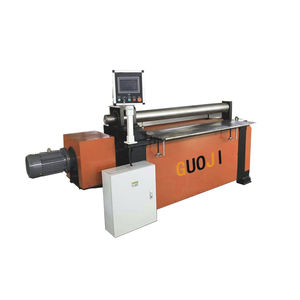
- Production Machines
- Forming Machine
- 2-roller plate bending machine
- Nantong Guoji Machinery Equipment Co.,Ltd.
- Company
- Products
- Catalogs
- News & Trends
- Exhibitions
2-roller plate bending machine GJW10-3X1500hydraulicautomaticCNC

Add to favorites
Compare this product
Characteristics
- Number of rollers
- 2-roller
- Operation
- hydraulic
- Other characteristics
- automatic, CNC
- Sheet thickness
Max.: 3 mm
(0.1 in)Min.: 1 mm
(0 in)- Sheet width
Max.: 1,500 mm
(59 in)Min.: 1 mm
(0 in)
Description
The automatic hydraulic 2 roller plate bending machine is a new type rolling machine on which a roll is made of steel and the other roll comprises a steel core covered by elastic layer(rubber roll). The plate can be arranged between rolls with adjustable distance. With process of contracting, pressurizing, rubber roll deforming, the plate is deformed and the rolled to specified shape when both rolls are driven to rotate. The equipment has advantages of forming in one piece, high production efficiency, high geometric accuracy of finished product, good surface quality and simple structure with fewer rolls. PLC(programmable logic controller) is adopted on equipment, so operation is simple and numerical control of production process can be easily realized.
Structural Features
1、The main rubber roller is specially processed by Japanese professional technology.
2、The entire hydraulic system has a small size, low noise, stable pressure, and a one year warranty.
3、The control system uses PLC control, control cabinet main electrical components one year warranty and lifetime maintenance.
4、The main frame steel plate welding structure, post-welding aging treatment.
5、Parts must be shot blasting slag, rust, after the anti-rust primer, putty painted topcoat. The appearance of the whole machine is clean and beautiful.
6、When the equipment is delivered, with the accessories of the machine, common tools, operating instructions, electrical diagrams.
Catalogs
No catalogs are available for this product.
See all of Nantong Guoji Machinery Equipment Co.,Ltd.‘s catalogsOther Nantong Guoji Machinery Equipment Co.,Ltd. products
GJW10-2 rolls plate bending machine
Related Searches
- Bender
- Tube bender
- Hydraulic bender
- CNC bender
- Automatic bender
- Section bending machine
- Plate roll machine
- Horizontal bending machine
- Precision bender
- Hydraulic plate roll machine
- 3-roll plate bending machine
- Rolling machine
- Vertical bender
- Digitally-assisted bending machine
- Bending rolling machine
- 4-roll plate bending machine
- Numerical control plate bending machine
- Conical plate bending machine
- CNC plate roll machine
- Steel plate rolling machine
*Prices are pre-tax. They exclude delivery charges and customs duties and do not include additional charges for installation or activation options. Prices are indicative only and may vary by country, with changes to the cost of raw materials and exchange rates.



